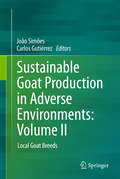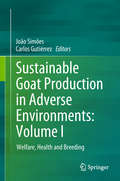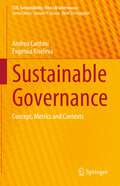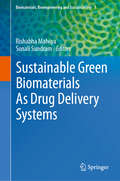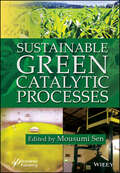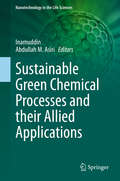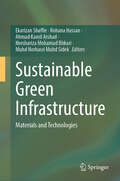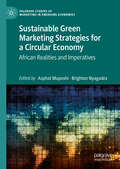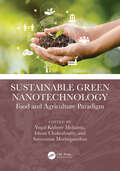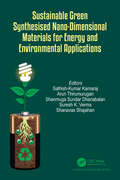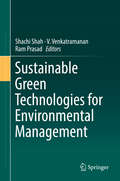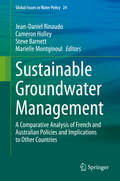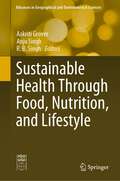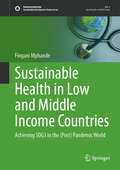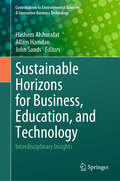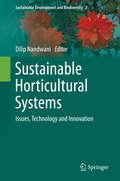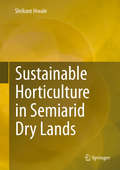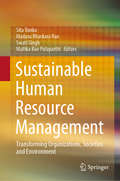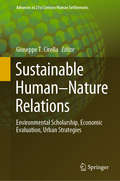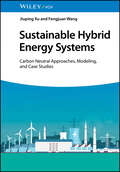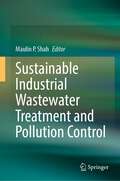- Table View
- List View
Sustainable Goat Production in Adverse Environments: Local Goat Breeds
by João Simões Carlos GutiérrezThis book covers more than 40 indigenous goat breeds and several ecotypes around the globe and describes genotypic and phenotype traits related to species adaptation to harsh environments and climate change. It also addresses sustainable global farming of local goat breeds in different production systems and agro-ecosystems. Discussing three main global regions: Asia, Africa, and Europe, it particularly focuses on adverse environments such as mountain, semiarid and arid regions. The topic of this highly readable book includes the disciplines of animal physiology, breeding, sustainable agriculture, biodiversity and veterinary science, and as such it provides valuable information for academics, practitioners, and general readers with an interest in those fields.
Sustainable Goat Production in Adverse Environments: Welfare, Health and Breeding
by João Simões Carlos GutiérrezThis book explores the current trends and challenges of sustainable goat meat and milk production in different global contexts, providing valuable insights into this industry in adverse environments like mountain, semiarid and arid regions. It also includes contributions from international experts discussing goat reproduction, genetic diversity and improvement, as well topics such as animal health, welfare, socioeconomic aspects, and many other issues regarding the environmentally friendly and economically viable exploitation of goats. This is a highly informative book providing scientific insight for readers with an interest in sustainable agriculture and socio-economic aspects, as well as goat breed conservation, genetic diversity, and veterinary care. These subjects are complemented in a second volume providing a detailed description of more than 40 indigenous goat breeds and several ecotypes found in Asia, Africa, Europe, and America.
Sustainable Governance: Concept, Metrics and Contexts (CSR, Sustainability, Ethics & Governance)
by Andrea Cardoni Evgeniia KiselevaThe role of governance as a fundamental pillar of sustainability is widely recognized and confirmed by its inclusion in the main ESG issues (environmental social governance). Through the complex role of governance in the context of ESG, research has developed the notion of sustainable corporate governance, i.e., a system based on the integration of shareholder and stakeholder objectives that protects the environment and the broader community. This book provides a sound theoretical definition, a precise measurement system, and best practice examples for the implementation of sustainable corporate governance. It includes theoretical foundations based on stakeholder and institutional theories from different environments and contexts, such as developed and developing economies, large publicly traded companies and SMEs, and family businesses. In addition to explaining the concept theoretically, it uses practical case studies to address the effective integration of sustainable governance into corporate structures. The book provides business students and researchers with an in-depth analysis of the emerging concept of sustainable governance and is valuable for academics as well as corporate and financial market participants.
Sustainable Green Biomaterials As Drug Delivery Systems (Biomaterials, Bioengineering and Sustainability #1)
by Rishabha Malviya Sonali SundramThe book provides a comprehensive exploration of sustainable practices in biomaterial development for biomedical applications, covering diverse topics such as green synthesis methods, the potential of biodegradable materials, renewable resources for biopolymers, strategies in polymer synthesis, bio-mediated nanomaterials, sustainable manufacturing techniques including 3D and 4D printing, protein-based biomaterials, composite biomaterials derived from cellulose, chitin, and chitosan, as well as hydroxyapatite-starch-based biomaterials, carbonaceous materials, eco-friendly synthesis of metal and metal oxide nanomaterials, silk fibroin scaffold synthesis, utilization of green catalysts, cellulose-derived hydrogels for tissue engineering, plant extract-mediated synthesis of metallic nanoparticles, and eggshell-derived biomaterial synthesis. This multifaceted approach addresses the pressing need for environmentally conscious solutions in the field of biomedical engineering, offering insights into the synthesis, properties, and applications of sustainable biomaterials. This book provides a comprehensive understanding of biodegradable materials, offering a valuable asset for researchers and Ph.D. scholars involved in the ever-changing field of sustainable biomedical engineering.
Sustainable Green Catalytic Processes
by Mousumi SenThis groundbreaking book offers an in-depth description of sustainable green catalytic processes that have emerged as the means to empower the existing protocols with greener, sustainable, and environmentally benign versions that hold enormous potential in industry and society. Growing worldwide concerns about environmental pollution and global warming have directed the attention of scientists towards approaches for developing sustainable protocols, and the need for employing greener and more sustainable catalytic approaches that are environmentally greener and more eco-friendly than current ones. Green and sustainable catalysts are the one class of catalysts that possess higher selectivity and activity, efficient recovery from the reaction medium, recyclability, cost-effectiveness and are prepared using environmentally benign preparation techniques. The most potent instrument in organic synthesis, and the cornerstone of green chemistry, is catalysis which has broadened the possibilities for organic transformations in the direction of a sustainable future. The catalyst has been playing a vital role, from the improvement of reaction conditions to enhanced selectivity towards the intended product and a decrease in the creation of byproducts. The purpose of this book is to highlight the developments made towards designing new catalysts (homogeneous, heterogeneous, organocatalyst, nanocatalyst, photocatalyst, nanophotocatalyst, biocatalyst, nanobiocatalyst, metal catalyst etc,.) and present the advancements in the field of chemical synthesis using greener catalytic routes with far-reaching applications. The other environmentally friendly method is the enzymatic synthesis of organic molecules, which substitutes safe reagents for those that imitate the biosynthetic route to synthesize the desired organic molecules. With its ability to produce transformations that occasionally enable the reduction of steps in a synthetic route, biophotocatalysis has long been recognized as a green technology and key to creating environmentally friendly and sustainable chemistry. The employment of sustainable green processes on the most crucial reaction steps of the synthetic protocol satisfies contemporary needs for environmentally friendly operations during the creation of valuable chemicals. Readers will find the book: details new catalysts development designs (homo and heterogeneous); presents the advancement of organic synthesis using greener catalytic routes with far-reaching applications; elaborates on preparation techniques for green and sustainable catalysts that possess higher activity, efficient recovery, and cost-effectiveness; discusses how to epitomize a green approach towards the preparation of organic moieties via enzymatic synthesis; analyzes nano-catalysis with green-based reagents and solvents that allow producers to follow the fundamental pillars of the green economy; elucidates green chemistry’s principles and metrics of the chemical’s life cycle and design through disposal. Audience The core audiences for this book include scientists and engineers working in green chemistry, materials science, photocatalysts, biotechnology, nanotechnology, waste minimization, and sustainability. This book is an excellent resource for graduate students, R&D experts, and researchers in academic and industrial fields of chemical synthesis.
Sustainable Green Chemical Processes and their Allied Applications (Nanotechnology in the Life Sciences)
by Inamuddin Abdullah AsiriUrbanization, industrialization, and unethical agricultural practices have considerably negative effects on the environment, flora, fauna, and the health and safety of humanity. Over the last decade, green chemistry research has focused on discovering and utilizing safer, more environmentally friendly processes to synthesize products like organic compounds, inorganic compounds, medicines, proteins, enzymes, and food supplements. These green processes exist in other interdisciplinary fields of science and technology, like chemistry, physics, biology, and biotechnology, Still the majority of processes in these fields use and generate toxic raw materials, resulting in techniques and byproducts which damage the environment. Green chemistry principles, alternatively, consider preventing waste generation altogether, the atom economy, using less toxic raw materials and solvents, and opting for reducing environmentally damaging byproducts through energy efficiency. Green chemistry is, therefore, the most important field relating to the sustainable development of resources without harmfully impacting the environment. This book provides in-depth research on the use of green chemistry principles for a number of applications.
Sustainable Green Infrastructure: Materials and Technologies
by Rohana Hassan Ahmad Kamil Arshad Muhd Norhasri Muhd Sidek Norshariza Mohamad Bhkari Ekarizan ShaffieThis book highlights the integration of eco-friendly infrastructure, innovative materials, and advanced technologies to build sustainability and resilience in both urban and rural environments. It explores the sustainability principles, highlighting how green infrastructure can reduce environmental impacts, improve quality of life, and ensure long-term ecological balance. The text emphasizes the importance of technological innovations in achieving sustainable development goals, offering insights into the latest advancements and their applications in creating resilient communities. It significantly contributes to the field by offering in-depth insights into sustainable development across various domains, including timber, pavement, construction, and technology. This volume is a crucial addition to existing literature, serving as an essential reference for future research and application in green infrastructure, materials, and technologies. Its wide-ranging content makes it an indispensable resource for professionals, scholars, and students dedicated to progressing the areas of green infrastructure and sustainable technological practices.
Sustainable Green Marketing Strategies for a Circular Economy: African Realities and Imperatives (Palgrave Studies of Marketing in Emerging Economies)
by Brighton Nyagadza Asphat MuposhiDeveloping countries are known to be ambivalent to making a transition to green economies due to a fear of investment costs related to clean technologies and the possibility of job losses. This book is founded on the proposition that green marketing governance is central to the transition to a circular economy. Building on seminal work on green marketing in emerging economies, this book develops a micro-macro perspective to present the realities and imperatives that facilitate or inhibit the realisation of the sustainable green marketing agenda in Africa. It examines the willingness of consumers to support sustainable consumption practices such as the sharing economy and to engage with circular economy practices such as recycling and reusing. It also critically reflects on the strategies, commitments and sacrifices that are required for the fulfilment of the sustainable green marketing agenda in Africa. The book is informed by the desired aspirations of the United Nations 2030 Agenda for Sustainable Development and Africa’s developmental blueprint, Agenda 2063.
Sustainable Green Nanotechnology: Food and Agriculture Paradigm
by Yugal Kishore Mohanta Ishani Chakrabartty Saravanan MuthupandianThe book places a strong emphasis on the significance of synthesizing nanomaterials and explores various methods of achieving this, with particular attention given to the production of environmentally friendly or "green" nanomaterials. This book illustrates the current gaps in the agriculture and food industry, and explores the potential applications of nanomaterials within this field. The integration of nanotechnology into the fields of biology and biochemistry holds the potential to exert a significant impact on the food industry in the future. This book comprehensively explores the various facets of design, utilization, and implementation of green nanomaterials within the agriculture and food industry. It delves into their applications in areas such as fertilizers, sensors, food processing, food packaging, and sustainable agricultural practices. Additionally, this book explores the current limitations and potential solutions in the field of green nanomaterials, highlighting their role in fostering a sustainable economy.Features: Addressing the global food crisis and presenting a picture of depleting food reserves Importance of nanomaterials and their efficient utilization Green synthesis of nanomaterials Utilization of green nanomaterials for development of smart and sustainable agriculture Emergence and growing application of green nanomaterials in the food industry Green nanomaterials towards a sustainable economy Existing challenges and limitations, with future prospects of using green nanomaterials in food and agricultural conversion devices
Sustainable Green Synthesised Nano-Dimensional Materials for Energy and Environmental Applications
by Sathish-Kumar Kamaraj Arun Thirumurugan Shanmuga Sundar Dhanabalan Shanavas Shajahan Suresh K. VeThere is a growing interest in applying the UN's sustainable development goals to a variety of sectors. One can use certain principles of green chemistry in the emerging fields of nanoscience and nanotechnology. The green chemistry approach focuses on the creation of nanodimensional materials that have a low environmental impact, are cost-effective, and have no negative consequences on the environment. This book aims to summarise the different alternative green chemical routes. Furthermore, the book describes the use of nano-dimensional materials for sustainable energy generation and environmental remediation applications.
Sustainable Green Technologies for Environmental Management
by Ram Prasad Shachi Shah V. VenkatramananOur Earth is considered as a natural system which organizes and controls itself. However, the present scale of anthropogenic activity is unprecedented in the history of mankind compelling the intelligentia to ponder over the scientific causes of the problems, processes and sustainable and pragmatic solutions. The current rate of resource use and consumption pattern are depleting the planet’s finite resources and damaging life-supporting ecosystems. A large number of toxic substances are increasingly found in air, water, soil, and flora and fauna. We are in the midst of a period of increasing interconnected and complex global challenges that seek action across temporal and spatial scales, diverse sectors, and concerted efforts from global citizens. The environment on account of human’s action has been experiencing imbalances and ecological catastrophe. Environmental issues like global climate change, biodiversity loss, the rapid depletion of natural resources, degradation of global commons, stratospheric ozone depletion have been restricting the safe operating space and transgressing the planetary boundaries endangering the existence of human societies. The global environmental problems if not scientifically managed may end up in the civilizational collapse. Nevertheless, the underlying commonality among these environmental issues is interrelatedness, complexity, and difficulty in identifying and implementing solutions. The global environmental challenges can be managed by adopting sustainable green technologies which dovetails the principles of environmental sustainability with social and ecological sustainability. Green growth is construed as a new development paradigm that sustains economic growth while at the same time ensuring environmental sustainability.
Sustainable Groundwater Management: A Comparative Analysis of French and Australian Policies and Implications to Other Countries (Global Issues in Water Policy #24)
by Steve Barnett Jean-Daniel Rinaudo Cameron Holley Marielle MontginoulThis book describes and analyses the diversity of possible approaches and policy pathways to implement sustainable groundwater development, based on a comparative analysis of numerous quantitative management case studies from France and Australia.This unique book brings together water professionals and academics involved for several decades in groundwater policy making, planning or operational management to reflect on their experience with developing and implementing groundwater management policy. The data and analysis presented accordingly makes a significant contribution to the empirical water management literature by providing novel, real world insights unpublished elsewhere. The originality of the contributions also lies in the different disciplinary perspectives (hydrogeology, economics, planning and social sciences in particular) adopted in many chapters. The book offers a unique comparative analysis of France, Australia and experiences in countries such as Chile and the US to identify similarities, but also fundamental differences, which are analysed and presented as alternative policy options – these differences being mainly related to the role of the state, the community and market mechanisms in groundwater management.
Sustainable Groundwater and Environment: Challenges and Solutions (Springer Hydrogeology)
by Peiyue Li Xiaodong He Vetrimurugan Elumalai Jianhua WuThis book addresses this challenge head-on, focusing on the intersection of groundwater sustainability and environmental health. It explores the complex relationship between groundwater management and environmental integrity, delving into topics like the impacts of groundwater extraction on ecosystems, the role of groundwater in climate change adaptation and mitigation, and the effects of surface water-groundwater exchange on groundwater quality. The book also highlights the latest scientific research, technological advancements in the field of sustainable groundwater management. Moreover, this book not only identifies the challenges but also proposes viable solutions. It presents a range of practices, innovative solutions, and policy recommendations to manage groundwater resources effectively while minimizing environmental impact. These will be drawn from a variety of contexts and case studies, making the book a comprehensive guide for researchers, policy makers, practitioners, and students in the field. By providing a holistic perspective on sustainable groundwater management, this book contributes significantly to our collective efforts toward achieving water security and environmental sustainability.
Sustainable Health Through Food, Nutrition, and Lifestyle (Advances in Geographical and Environmental Sciences)
by R. B. Singh Aakriti Grover Anju SinghThis book uncovers the multiple layers of challenges posed to achieve sustainable human health and improves the understanding of interactive areas set by the UN Sustainable Development Goals (1) no poverty, (2) zero hunger, (3) good health and wellbeing, (6) clean water and sanitation, and (11) sustainable cities and communities. The book focuses on conceptual understanding, food, nutrition, lifestyle, and their integration to reinforce the ideas of holistic health principles.' The most important drivers of sustainable health are food, nutrition, and lifestyle. Healthy food is a basic need of human beings. In under-developed regions, people are underweight and facing malnutrition, with a prevalence of deficiency diseases due to low intake of micro-nutrients such as vitamin A, iodine, and protein among others. A good diet as well as lifestyle has a tremendous bearing on a person’s health, emotional stability, and enthusiasm for life. The global coronavirus pandemic has brought unimaginable devastation and hardship in all corners of the globe, questioning the existing healthcare services, health policies, and health planning across the developed and developing countries. It has also exposed the lacunae in understanding health, the base of human happiness. The global community needs to gravely ponder the health issues we are facing and explore sustainable solutions for health recovery and the wellbeing of humanity.
Sustainable Health in Low and Middle Income Countries: Achieving SDG3 in the (Post) Pandemic World (Sustainable Development Goals Series)
by Fingani MphandeThis book highlights lessons from the COVID-19 pandemic and explains how these can be used to build sustainable health systems, especially in Low- and Middle-Income Countries (LMIC). It investigates the impact of outbreak response and management on health sustainability in LMIC from the perspective of SDG3: “Ensuring healthy lives and wellbeing for all at all ages”. Despite strides being made in some areas for SDG target 3.3 to fight communicable diseases, the COVID-19 pandemic has caused interruptions that will considerably affect vaccination coverage as well as the progress that was made, for example: in reducing malaria cases. Vulnerable populations who were already struggling to access their healthcare needs before the pandemic may face even greater challenges at present and in the years to come, post-pandemic. This book considers the progress on attaining the SDG3 targets, specifically: to improve early warning systems for management of national and global health risks, and the effect of pandemics - including but not limited to the COVID-19 pandemic - and emerging disease outbreaks. It explores the weaknesses and strengths in LMIC and how to strengthen capacities in these countries. The author also investigates and proposes approaches that can, or should, be implemented to ensure sustainable health systems in developing countries, including early warning systems, risk reduction, and the management of global and national health risks. This book is of great interest to public health professionals, infectious diseases experts, and epidemiologists, as well as students and researchers of public health systems and healthcare infrastructure in developing countries.
Sustainable Horizons for Business, Education, and Technology: Interdisciplinary Insights (Contributions to Environmental Sciences & Innovative Business Technology)
by Allam Hamdan Hashem Alshurafat John SandsThis book offers a detailed analysis of the intersection of sustainability, innovation, and global progress, and it comprehensively explores sustainable practices and their impact on business, education, and technology. The book shows how businesses can incorporate sustainability into their core operations, including environment-friendly supply chains, renewable energy adoption, circular economy models, ethical decision-making, and sustainable growth strategies. Successful sustainable businesses and the benefits of their socially responsible practices are highlighted. In addition, the book explores how education can shape a sustainable future. It is necessary to integrate the ideas of sustainability into the curricula of early childhood education to higher learning institutions to educate and empower the next generation of changemakers. The role of technology in advancing sustainability efforts is also investigated, including artificial intelligence, blockchain, clean energy solutions, green architecture, and smart cities. Other topics explored in the book include global sustainability efforts such as international collaborations, public-private partnerships, and multilateral initiatives; the role of governments, NGOs, and international organizations in promoting sustainable development; ethical considerations and social impacts of sustainable practices, for example, social justice, inclusivity, and environmental stewardship; connections between sustainable development and improved quality of life; and groundbreaking ideas and innovations for industries to tackle sustainability issues. The book offers a comprehensive and forward-looking perspective on sustainability. By combining different viewpoints, the book empowers readers with the knowledge and inspiration to contribute meaningfully to a more sustainable, inclusive, and resilient world.
Sustainable Horticultural Systems
by Dilip NandwaniSustainable horticulture is gaining increasing attention in the field of agriculture as demand for the food production rises to the world community. Sustainable horticultural systems are based on ecological principles to farm, optimizes pest and disease management approaches through environmentally friendly and renewable strategies in production agriculture. It is a discipline that addresses current issues such as food security, water pollution, soil health, pest control, and biodiversity depletion. Novel, environmentally-friendly solutions are proposed based on integrated knowledge from sciences as diverse as agronomy, soil science, entomology, ecology, chemistry and food sciences. Sustainable horticulture interprets methods and processes in the farming system to the global level. For that, horticulturists use the system approach that involves studying components and interactions of a whole system to address scientific, economic and social issues. In that respect, sustainable horticulture is not a classical, narrow science. Instead of solving problems using the classical painkiller approach that treats only negative impacts, sustainable horticulture treats problem sources.
Sustainable Horticulture in Semiarid Dry Lands
by Shrikant HiwaleThis book discusses ways of increasing production/unit area by making full use of the soil and water under the harsh climatic conditions of semiarid areas. This leads to improved sustainability, increased availability of fresh produce, which is vital for human health and higher incomes for small and marginal farmers. Arid and semiarid areas account for almost 70 per cent of the total cropped area of India. In these areas physical constraints like low and erratic rainfall, high temperature, high wind velocity, low fertility, poor soil structure, salinity of soil and ground water all limit reliable crop production. In the absence of any type of aggregation, the soils are highly erodible, lack structure and have a very coarse in texture with low water holding capacity. Intensive agricultural practices, increasing population pressure, climatic changes, environmental pollution, loss of biodiversity, soil erosion, salinization and water depletion are all threatening the sustainability of agriculture. In view of the mounting demand for food, it is vital to link enhanced food production with nutritional security, conservation of natural resources, increasing farmers' incomes, employment generation through agricultural diversification. Horticulture, particularly of fruit trees, can play a major role in solving the problem of nutrition, as fruits are rich source of vitamins and minerals and have antioxidant properties. Fruit trees, which are mostly deciduous, add leaf litter to the soil, and this ultimately helps to improve the condition of the soil. In addition, fruit trees are known to reduce soil erosion and reduce run off. The trees also play a major role in purifying the environment as they are the known carbon sequesters. Fruit-tree cultivation is a profitable preposition. There is no scope to increase the land surface; all increase in productivity therefore has to be from the available land. This means introducing cropping systems that can meet the basic food, fodder and fuel requirement of farming families.
Sustainable Houses and Living in the Hot-Humid Climates of Asia
by Tetsu Kubota Hom Bahadur Rijal Hiroto TakaguchiThis book provides information on the latest research findings that are useful in the context of designing sustainable houses and living in rapidly growing Asian cities. The book is composed of seven parts, comprising a total of 50 chapters written by 53 authors from various countries, mainly in the Asian region. Part I introduces vernacular houses in different Asian countries such as Indonesia, Malaysia, India, Nepal, China, Thailand and Laos. Parts II and III then explore in depth indoor adaptive thermal comfort and occupants’ adaptive behavior, focusing especially on those in hot-humid climates. Part IV presents detailed survey results on household energy consumption in various tropical Asian cities, while Part V analyses the indoor thermal conditions in both traditional houses and modern houses in these countries. Several real-world sustainable housing practices in Asian cities are reviewed in the following part. The final part then discusses the vulnerability of expanding Asian cities to climate change and urban heat island. Today, approximately 35-40% of global energy is consumed in Asia, and this percentage is expected to rise further. Energy consumption has increased, particularly in the residential sector, in line with the rapid rise of the middle class. The majority of growing Asian cities are located in hot and humid climate regions, and as such there is an urgent need for designers to provide healthy and comfortable indoor environments that do not consume non-renewable energy or resources excessively. This book is essential reading for anyone with an interest in sustainable house design in the growing cities of Asia.
Sustainable Human Resource Management in Tourism: African Perspectives (Geographies of Tourism and Global Change)
by Tom Baum Ann NdiuiniThis book addresses the application of sustainable HRM principles within tourism in the specific context of Africa, a neglected area of study. It draws on diverse aspects of HRM, from the micro- (individual) through the meso-level (organisational) to the macro-level (policy, governmental). It also reflects the diverse challenges facing a critical area within emerging African tourism, that of its workforce. The book is substantially research-based and provides a state-of-the-art picture of emergent studies in this area, drawing on case examples from a wide-range of African contexts. As such, it provides a comprehensive resource and starts discussion in an emergent research area.
Sustainable Human Resource Management: Transforming Organizations, Societies and Environment
by Sita Vanka Madasu Bhaskara Rao Swati Singh Mallika Rao PulaparthiThis book provides a multi-stakeholder perspective on sustainable HRM for the policymakers, managers and academics, addressing issues, approaches, research studies/frameworks and emerging patterns relating to the subject. It discusses various aspects of sustainability, such as making HR more responsible for ensuring sustainability focusing on the triple bottom line, characteristics of sustainable HRM, psychological contracts, emotional intelligence, and psychological capital. The book also explores organizational citizenship behavior, employment relations, employee engagement, sustainable leadership, disruptive HR practices, sustaining employee motivation, educational sustainability, sustainable career management, sustainable environment, employer and employee branding, sustainable organizations, organization culture, training for sustainability, sustainable employee performance, business sustainability and sustainable employability. It provides an update on the concept, processes, issues and emerging paradigms from multidimensional and cross-country perspectives to showcase sustainable HR practices, and appeals to the academics, practitioners and policymakers in the area of HRM.
Sustainable Human–Nature Relations: Environmental Scholarship, Economic Evaluation, Urban Strategies (Advances in 21st Century Human Settlements)
by Giuseppe T. CirellaThis book addresses sustainability thinking and the bigger picture, by taking into consideration how and from where contemporary schools of thought emerged approximately a quarter-century ago. Evidence from the literature illustrates a number of key concepts and techniques that have been tested and continue to be tested, within various multi-disciplinary fields, on societal functionality. Research into sustainable societies needs to be sound, ethical, and creative. A cross-sectoral, interdisciplinary examination of challenges and strategies is used to interlink sustainability thinking and human-nature relations. With an ever-growing number of people now concentrated within urban areas, providing not only environmental quality and livable space, but also security and resilient urban systems, is becoming increasingly important. This urbanization trend has overlapped with environmental degradation, consumption of natural resources, habitat loss, and overall ecosystem change. Consequently, the goal is for cleaner, safer societies – with higher standards of living – to excel in support of current and future generational communities. The book tackles these challenges by integrating environmental scholarship, economic evaluation, and urban strategies under one umbrella of thought. The relational paradigms presented include examples that correlate developed and developing countries, socioeconomics and community development, and governance of knowledge and education. As such, the book argues, furthering of knowhow should be accessible and shared in order to achieve maximum innovation and benefit. Sustainability thinking, after all, is a metric for intrinsic human-nature relations in terms of past performance, present development, and future goals. This book discusses this metric and offers novel approaches to growing societies and what we can do next.
Sustainable Hybrid Energy Systems: Carbon Neutral Approaches, Modeling, and Case Studies
by Jiuping Xu Fengjuan WangSustainable Hybrid Energy Systems Discovering comprehensive approaches to build sustainable hybrid energy systems Hybridization is the eternal theme of human energy utilization. However, it has never been more important than it is now because of the urgency of promoting energy transition and achieving carbon neutrality. Therefore, exploring the design, combustion, operation, and policy challenges of sustainable hybrid energy systems becomes increasingly important. Sustainable Hybrid Energy Systems: Carbon Neutral Approaches, Modeling, and Case Studies provides a detailed explanation of these aspects. Dividing hybrid energy systems into three categories—co-located, co-combusted, and co-operated, this book emphasizes the deployment optimization, emission quota allocation, scheduling coordination, and renewable portfolio standards implementation of these systems. The results are essential tools for understanding the current and future of multi-input single-output hybrid energy systems. Sustainable Hybrid Energy Systems readers will also find: Clear logical framework that reveals the constitutes of hybrid energy systems.Systematic technical scheme for building an economic, environmental, flexible, and resilient future energy system.Extensive case studies from single power plant level, multiple power plant level, and grid level.Effective guidelines for wider application of the proposed carbon neutral approaches. Sustainable Hybrid Energy Systems is ideal for power engineers, electrical engineers, scientists in industry, and environmental researchers looking to understand these energy solutions. It will also provide collectible value for libraries.
Sustainable Hydrogen Production Processes
by José Luz SilveiraThis work presents a comprehensive investigation of the most significant renewable hydrogen production processes. Technical, economic and ecological studies are described for the processes of steam reforming of ethanol, natural gas and biogas; water electrolysis with energy from renewable sources (wind power, photovoltaic and hydroelectric), and hydrogen production using algae. Aimed at mechanical and chemical engineering graduate students and researchers involved in environmental sciences, sustainable energy and bioenergy research, this book introduces readers to the latest developments in the field and provides essential reference material for future research. The book first presents a comprehensive literature review of the processes studied. Subsequently, it provides a technical report on assessing the energetic efficiency for each hydrogen production process, as well as an economic study of the respective hydrogen production costs. Lastly, the ecological efficiency of each process is addressed. Over the past few decades, the UNESP's Group of Optimization of Energetic Systems, headed by Professor Jos#65533; Luz Silveira, has been pursuing research in the field of renewable energy generation. A major part of the group's research focuses on the production of hydrogen as a fuel and its important contribution to mitigating the environmental impacts caused by pollutant emissions.
Sustainable Industrial Wastewater Treatment and Pollution Control
by Maulin P. ShahThis book summarizes the advanced sustainable trends in removing toxic pollutants by environmental and biotechnological processes from both industrial wastewater and sewage wastewater. The book also provides an assessment of the potential application of several existing wastewater bioremediation techniques and introduces new cutting-edge technologies. Among other valuable information covered, here are the methods, procedures, materials (especially low-cost materials originating from industrial and agricultural waste), management of wastewater containing toxic pollutants, and valorization possibilities of waste resulting from the removal of toxic pollutants from wastewater.Tonnes of hazardous waste pollutants released by industries are a challenge worldwide. With the ever-growing population and shrinking landfill areas, managing the disposal of pollutants is a matter of severe concern. Industrial wastewater treatment, recycling, and reuse are serious issues in today’s context, not just to protect the environment from pollution, but also to conserve water resources so that water stress is reduced.This book is designed for engineers, scientists, and other professionals and serves as a good summary of the current state-of-the-art and innovative research challenges to control pollution for coming generations.
